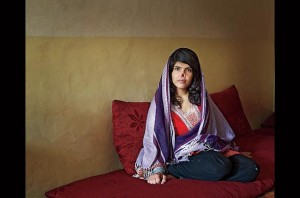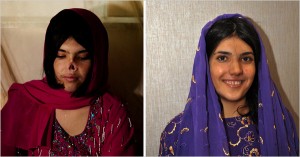 The young Afghan woman on the cover of Time (see last post) is beautiful, as all the photographic cues imply she should be. Except … she doesn’t have a nose. The contrast between the sumptuousness of the photo and the missing nose increases the shock value of the image.
The young Afghan woman on the cover of Time (see last post) is beautiful, as all the photographic cues imply she should be. Except … she doesn’t have a nose. The contrast between the sumptuousness of the photo and the missing nose increases the shock value of the image.
For many in the wealthy West, what this image undoubtedly brings to mind is the thought: “She could get that fixed.”
Sure enough, Time managing editor Richard Stengel tells us:
Aisha will head to the U.S. for reconstructive surgery sponsored by the Grossman Burn Foundation, a humanitarian organization in California.
If we didn’t know the surgery had already been arranged, any number of wealthy individuals or organizations would undoubtedly have stepped forward with an offer. In fact, the organization Women for Afghan Women reports that, in response to their outreach efforts for Bibi Aisha,
the response has been tremendous. We have had several offers from doctors and medical professionals in the United States for free travel to the United States, surgery and care for Bibi Aisha. There have also been Kabul-based doctors who have offered to do her surgery for free. The generous outpouring of offers of help has been moving for all of us, particularly for Aisha.
In March, the problem was getting Aisha out of Afghanistan.
Three factors have contributed in a delay in Aisha’s visa: she is from the South of Afghanistan; she does not have her husband’s or father’s permission to leave the country; and she does not have an Afghan I.D card (the equivalent of a birth certificate in the U.S).
While the Time magazine cover focused attention on Aisha, her story is not new. It was told last December by The Daily Beast and in March by ABC News.
Whatever can be fixed, should be fixed
The availability of cosmetic surgery has forever changed our assessment of others. In his wonderful essay, “Emily’s Scars,” Arthur W. Frank observes:
I noted that my judgmental reaction to another’s body was shaped by my coincidental assessment that surgeons work on conditions like that. Judgment conflates the body itself with the quality of work done on that body or the potential to have that work done. The possibility of fixing renders inescapable the question of whether or not to fix.
This observation was voiced by anthropologist Margaret Mead back in 1974.
Once there is a possibility that the defect can be reduced or minimized or compensated for, our attitude changes from one of painful inattention to active concern. Something should be done…. Whatever is wrong that can be fixed, should be fixed.
In the case of Bibi Aisha, she’s not scheduled for cosmetic enhancement, but medical treatment. The line between the two is a matter of dispute, since self-esteem now qualifies as a medical issue. But in this particular case, there’s no doubt which one it is.
Update 10/13/10:
Bibi Aisha, Disfigured Afghan Woman Featured On ‘Time’ Cover, Visits U.S. (NPR)
On Saturday, Aisha appeared at a Grossman Burn Foundation fundraiser in a traditional embroidered caftan and a sheer scarf draped over her wavy black hair. It was the first time she’d been seen in public since arriving in the U.S. The radiant 19 year old was wearing a prosthetic nose, something that indicated how she would look when the several reconstructive surgeries are completed. She didn’t speak, but her smile said everything.
Aisha was wearing the kind of nose actors often do for a part. Her goal is still to have a permanent one. But getting there will be a tough slog: she’ll have to have bone and cartilage reconstructed, possibly from flaps of her own skin and several surgeries. But within a year, doctors expect she’ll have a nose that not only completes her face, but that can do what her old nose did — twitch when it itches, smell, even sneeze.
The smile that defies the Taliban: Afghan teenager whose mutilated face shocked the world unveils her new image (The Daily Mail)
She [Aisha] went before the TV cameras to receive the Enduring Heart award at a benefit for the Grossman Burn Foundation – the Los Angeles-based organisation that paid for her surgery.
She was given the award by California first lady Maria Shriver.
Arnold Schwarzenegger’s wife told the audience: ‘This is the first Enduring Heart award given to a woman whose heart endures and who shows us all what it means to have love and to be the enduring heart.’
Aisha, whose surname has not been revealed, replied: ‘Thank you so much.’
Update 12/9/10:
Arrest Made in Afghan Disfigurement Case (New York Times)
Interesting details on recent developments. Father-in-law “took her amputated nose and proudly showed it off around the village.”
Father of mutilated Afghan girl fears attackers will escape law (Guardian)
Father-in-law arrested, but according to Aisha’s father, “It is just a matter of knowing the right person in Uruzgan and you can get out of prison.”
Image source: New York Times
Related links:
The death of Wang Bei: Cosmetic surgery as a moral choice
Mutilated Afghan woman on the cover of Time
The problem in Afghanistan is hunger
The enduring benefits of saving children
Novartis gender discrimination verdict: Guilty as charged
Resources:
Image source: Time
The Grossman Burn Centers Provides Care and Hope for Bibi Aisha from Afghanistan, Grossman Burn Foundation
Stories of brave women fighting for their rights against all odds, Women for Afghan Women, March 17, 2010
Arthur W. Frank, Emily’s Scars: Surgical Shapings, Technoluxe, and Bioethics, Hastings Center Report, March-April, 2004
For the Margaret Mead quotation, see Elizabeth Haiken, “The Michael Jackson Factor: Race, Ethnicity, and Cosmetic Surgery” from Venus Envy: A History of Cosmetic Surgery
On the question of enhancement vs. medical treatment, see Erik Parens, Enhancing Human Traits: Ethical and Social Implications
The video is from Margaret Aro and Mark Mooney, Exclusive: The Secret Shelters That Protect Afghan Women, ABC World News, March 11, 2010




wow i am so glad she is ok!!!!! i feel bad for her!!!
Hi Sally – According to an article in the New York Times (http://nyti.ms/hF2uW1), Aisha is living in Brooklyn, getting treatment for the emotional scarring of what she endured. The foundation in California that has offered to do the reconstructive surgery felt it was necessary to deal with the trauma first.